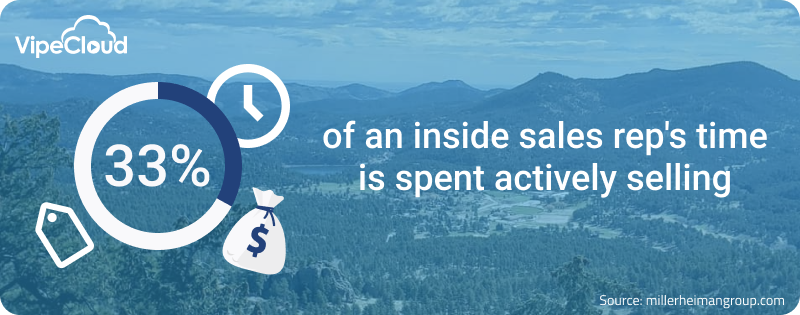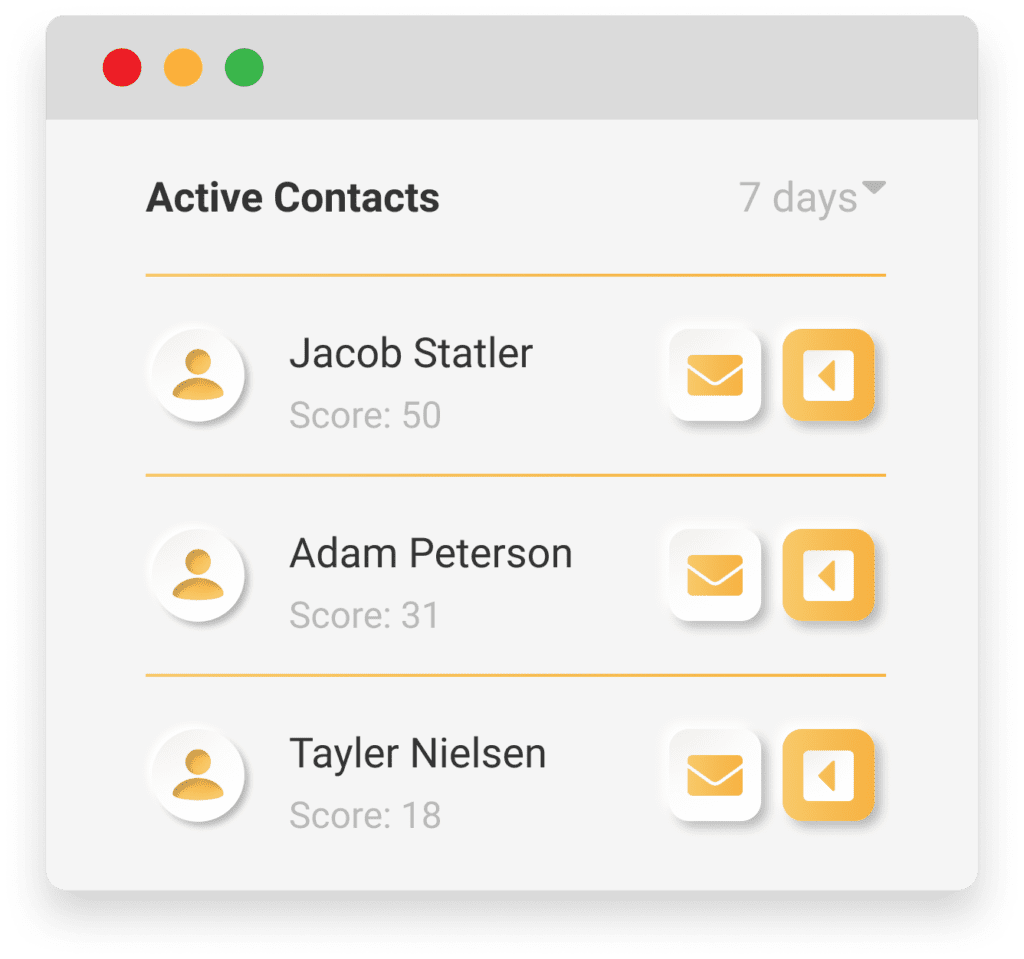Last updated on August 2nd, 2023

This guide will help you implement lead scoring practices, so you can double down on deals with the highest potential!
If you take a big-picture view of your sales cycle, you’ll notice certain patterns when it comes to the demographics of your ideal customers and their behaviors.
These observations you make can help you categorize your leads based on a numeral ranking system called lead scoring.
Lead scoring is great to have in place, but if you aren’t implementing the best practices — you may not see much success.
By the end of this guide, you’ll learn:
- What Is Lead Scoring All About?
- How Do You Score Leads?
- What Are The Lead Scoring Best Practices?: 7 Cardinal Rules
- How Do You Build An Effective Lead Scoring Process?
- How Do You Know If Your Lead Scoring Process Is Working?
- What Can I Use To Score Leads Effectively?

VipeCloud is the only Automation tool your small business needs to
be the hero to your customers.
With Email, Texting, Social, Suites, Chat, Stories, Video Email & Sign Up Forms fully built-in, we provide you with the perfect platform to grow your business.
15 Day Free Trial – Get started risk free. No CC needed.
What Is Lead Scoring All About?
Lead scoring is a way of qualifying that gives leads a number to indicate how sales-ready they are.
Companies create point thresholds (point ranges) that act as “zones” for the following:
- MQLs – Marketing Qualified leads
- SQLs – Sales Qualified Leads
The higher a lead scores, the more of a priority they should be to your organization because both of you can benefit from doing business with each other.
Leads are scored based on two scales:
- Demographics – (age, gender, title, industry, company size)
- Behavior – (actions they take – visiting your website, downloading email attachments, booking calls, etc.)
Your lead scoring system adds up numbers from these two scales to determine a lead’s value to your company.
Typically, behavioral points hold more value because they portray a lead’s interest in your company the most!
So the million-dollar question now is: Why is lead scoring crucial in the first place?
Why Is Lead Scoring Crucial?
For starters, lead scoring helps you make smarter marketing and sales decisions using data.
Lead scoring best practices allow you to pinpoint who’s not a fit, sales-ready, and who needs nurturing (more marketing.)
And you guessed it:
Your sales team saves hours by speaking to the right prospects and overall being more productive.
(Which is especially important since only 33% of inside sales rep time is spent actively selling.)

I’ll also add this:
Knowing and applying lead scoring best practices is just as important because it’s the only way to ensure you use your lead scoring tool successfully.
Simply put, lead scoring is a powerful tool, but if you don’t know how to use it, you’re just sitting on potential.
How Do You Know If You Need Lead Scoring?
Before we continue, you need to identify if you need lead scoring in the first place.
Companies that experience the following are in dire need of lead scoring:
- You have high lead volume but low conversion rates
- Longer sales cycles compared to industry standards
- Marketing and sales miscommunications
- You’re unsure who you should be following up with
- You can’t differentiate between your MQLs and SQLs
With that down, let’s discuss how to score leads!
How Do You Score Leads?
When it comes to scoring leads, you first want to make sure you’re using an all-in-one CRM.
Why?
Because marketing and sales data gets synced in one place and does not run the risk of losing key information.
(Not to mention: the countless marketing and sales tools at your disposal.)
When scoring leads, you have to start with explicit (demographic) and the implicit (behavioral) data of your leads.
With implicit, you want to assign values to specific behaviors in your lead scoring software. For example, you can give 5 points for a website visit, 10 points for visiting 5 pages, 25 points for a sign-up, and 50 points for booking a call.
On top of that, with the information your lead has laid out on their sign-up form, your lead scoring system will add or subtract points based on what they’ve inputted (explicitly.)
So if you’re in the B2B space and your lead’s title is CEO, then they gain points because they’re likely a key decision-maker and they match the title you’re looking for.
By gaining these points, your lead is becoming more and more sales-qualified because they’re nearing your sales-qualification threshold.
What Are The Lead Scoring Best Practices?: 7 Cardinal Rules

1. Marketing & Sales Must be on The Same Page
If your sales and marketing CRM has to be in sync, then you bet your organization needs to as well!
Your marketing and sales teams need to know what lead scoring is all about, its importance, and your company’s implementation of it.
Because if one or a few people are lost, it can spell disaster!
Being on the same page means your marketing and sales departments firmly understand how lead criteria are scored, customer behaviors, and your demographic.
It’s a good idea to include lead scoring training and “plays” in your sales playbook, so it can be revisited when needed.
2. Prioritize Valuable Actions
When scoring your leads on the behavioral side of your lead scoring system, it’s essential to understand what actions take priority.
Basically you’re giving a higher reward for actions that are closest to what a buyer would do.
Here’s an example:
Booking a demo call on your website and joining your webinar are positive actions, but the demo call is more valuable.
Why?
Because it’s closer to what a buyer would do (speaking with you to learn more about your product.)
As a result, giving more points to booked calls would help separate who’s closer to a buyer than not.
It’s a great idea to sit down with business partners and managers to pinpoint your most important “buyer” behaviors and put them as their own point thresholds.
3. Get Specific About Your Demographics
Getting specific ensures that your lead scoring system works with as much detailed data as possible.
Say a marketing agency’s online form has a section that asks leads to select their marketing budget range, something like this:
- $5,000 – $10,000
- $15,000 – $30,000
- $50,000 – $100,000
This agency can give higher lead scoring value to bigger marketing budgets, showing that the prospect is likely a bigger deal size.
With more specific demographic information, the way you score leads gets even more accurate.
4. Give A Minimum Scoring Requirement For MQLs
It’s known that not everyone in your funnel will make it to EVERY stage of your funnel.
There’s a natural drop-off at each progressive stage, but this doesn’t mean these drop-offs aren’t useful for you.
Here’s what I mean:
When scoring your leads, there will be people who aren’t fit for a sales meeting but are fit to be marketed to.
It can be a timing issue, budget problem — whatever the current roadblock is — that doesn’t mean they’ll have the same roadblock in the future.
So the best thing to do is create an MQL threshold for individuals who need nurturing. (Again, a lead scoring range that they fall into.)
When someone is an MQL, you can watch what behaviors they do that’ll gradually bring them up into a SAL (Sales Accepted Lead) and eventually a SQL (Sales Qualified Lead.)
5. Implement Negative Scoring
Negative scoring is when you subtract points (explicitly or implicitly) from a lead because they aren’t showing buyer cues.
Many organizations may deduct points for the following reasons:
- Inactivity across select time frames (months, quarters, years.)
- Informational bounces (wrong emails, phone numbers, etc.)
- Unserviceable geographical locations
Negative scoring is a great way to automate lead disqualification without you having to do it manually.
Remember to prioritize the most telling actions still. So, for instance, deducting more points for informational bounces than inactivity would make a lot of sense.
6. Speak With Your Customers
Your customers were leads at one point, and there was something about your product, marketing, and sales process that motivated them to work with you.
They’re a notable resource for you to gain information from because you can ask them in-depth questions about their customer journey.
Sure, you may see their journey in your CRM, but there are still intangibles, like what whitepapers they downloaded that made them more receptive or the sales rep they spoke to.
Once you piece together feedback commonalities, you can better predict how a similar prospect will behave!
Maybe there’s a new prospect in the same industry as your customer, with similar company size and lead score.
The feedback from your customer can be the perfect blueprint on what to do with that prospect.
7. Get Feedback From Your Sales & Marketing Team
When you’ve implemented your lead scoring system and automation, gaining feedback is paramount.
Maybe your sales team finds it very valuable but still has suggestions to improve your lead scoring model.
Or perhaps, you need to increase your lead volume because a high percentage of leads seem not to be fit for sales.
With the feedback of your sales and marketing reps, you can tweak whatever is needed.
How Do You Build An Effective Lead Scoring Process?

In this section, we’ll detail a step-by-step process for lead scoring.
By implementing these steps, you’ll change the way you approach marketing and sales drastically!
1. Select A Lead Scoring System
Your lead scoring system is the tool that will record important lead information based on their email, website, and form engagements. It’s also the place where you set your point-scoring criteria.
An all-in-one CRM like VipeCloud’s Sales & Marketing Suite has a lead scoring feature called “contact scoring.”

This would be a perfect starting point for you because you’re syncing your sales and marketing data with ease.
Not to mention it’s outstanding compatibility with small and medium-size businesses!
2. Set Your Highest Value Score
Once inside your lead scoring system, you want to set your highest value score. This is the maximum number of points a lead can get at one time.
If it’s the most points, you can tell that it’s for the most critical actions.
Here’s an example of a scoring scale that caps at 80.
- 5 points → Demographic: Title, industry, geography
- 10 points → Demographic: Ideal revenue per year
- 25 points → Action: Visited 10 website pages
- 50 points → Action: Email attachment download
- 60 points → Action: form-signup
- 80 points → Action: Calendar booking
Although points can be awarded manually, automation is the way to go! So be sure to set automation for your point values to save your sales team time and energy.
3. Create Your Demographic Point Scale
This is about listing characteristics of your ideal demographic and giving each attribute a score.
Of course, these would be things that your hottest leads share, like geographical location, title, and industry.
Remember to include the attributes you’re scoring in EACH one of your lead forms. (That way, you give fair scores to each person that signs up.)
Here’s what I mean:
If you have 6 different forms and one form is missing the “Job title” field, this may throw off the scoring for the leads that use that form compared to your other ones.
Pro-Tip: Make form fields required so that they have to be filled out for the form to be submitted.
In the long run, this will help you qualify people in an automated fashion as you scale.
(Bonus Pro-Tip: If possible, leverage reCAPTCHA to prevent spammers from submitting information on your forms. We cover this more in our lead capture pages article.)
Building conversion-optimized online forms is super easy using VipeCloud’s sign-up forms.

Add your most important form fields and easily craft an offer that will act as your lead magnet!
4. Create Your Behavioral Point Scale
Next, make a list of behaviors that show a level of interest in your company, and rank them from most important to least important.
Again, a good way to narrow down the most important behaviors is by looking at high-value buyer cues. (Things like booking a call, signing up for a form that’s related to purchasing, and so on.)
Your behavioral (implicit) points should overall be higher than your demographic (explicit) points because these are tangible actions your leads are doing rather than who they are.
If this may seem hard to remember, just adhere to the phrase “Actions speak louder than words.”
So let’s say lead A is a CEO in your ideal industry, with the right company size, but she barely opens emails and doesn’t download ANY email content.
On the other hand, Lead B is one of 3 decision-makers in the same industry, has a slightly smaller company size, but he opens 80% of your emails, clicks your links, and visits your website.
As you can see, lead B’s explicit information may not be as great as lead A, but he’s more likely to be a buyer because his actions prove so.
Thus, Lead B should be accumulating more points because his actions are showing that they’re interested!
5. Add Your Negative Scores
These will be for leads that are or show that they aren’t a good fit.
This comes in handy in the long term and will help prevent wasted time contacting unqualified people.
Here’s a deduction model to get your ideas flowing:
- Inactivity across 60 days → -10 points
- Incorrect information (emails, phone numbers, etc.) → -25 points each
- Non-decision maker/wrong job title → -50 points
- Unserviceable geographical locations → -75 points
6. Enable Your Lead Scoring System & Test It
With your lead scoring system good to go, you want to test it out.
After all — car companies don’t just throw engines on cars without running tests, right?
You can test your lead scoring system by creating demo prospects and entering varied information.
- Enter the information of an ideal prospect
- Enter the information of a so-so prospect
- Enter the information of an unqualified prospect.
After that, do certain behaviors associated with each prospect across a couple of days. Then, compare how they’re scored and the accuracy of it!
Approaching this testing phase like a science experiment is how you can note and fix errors.
7. Continually Audit Your Lead Scoring Process
Just like many systems in business, you’ll have to revisit them and tweak them as time goes on. The truth is your business is constantly changing, and so your business systems should as well.
Maybe you’re beginning to scale, and you’re looking to broaden your customer base and explore new markets.
Or your product has evolved and is becoming more suited for a niche audience.
Whatever the case, business changes mean system changes.
Your data is the best way to tell how your sales cycle has improved since implementing lead scoring.
Let’s talk about how to know if your new implementation is working!
How Do You Know If Your Lead Scoring Process Is Working?

Here’s the scoop:
Track your conversion rates between leads that go from MQLs to SALs and SQLs.
The better the conversion, the more likely that your MQL threshold is accurate! If your sales team accepts more leads and your lead volume is relatively the same as before, that means the people you’re marketing/nurturing are a better fit overall.
Another way to tell if your lead scoring process is spot on is what your sales team is reporting.
Because, after all, they’re the ones having conversations and email communications with the leads.
If they love the higher quality of prospects, then you’re on the right track. It’s ideal to give this about 30-60 days to get accurate feedback.
Also, If your own “deals won” percentage increases in your CRM, it indicates more qualified buyers!
And lastly, if your sales cycle is becoming shorter, it could result from higher quality leads going through sales.
What Can I Use To Score Leads Effectively?
Effective lead scoring comes down to collaborating with your organization to pinpoint your buyer demographic and behaviors.
With a point scale in place, you can better categorize who you need to be speaking with and at what time.
VipeCloud’s contact scoring feature is a fantastic way to create lead scoring automation that’ll grow with you as your business changes.
Contact scoring is inside VipeCloud’s Sales and Marketing Suite, where you also gain access to sign-up form builders, email automation systems, a spot-on sales reporting dashboard, and much more.
It’s a marketing and sales powerhouse that business owners are loving.
Try VipeCloud’s Sales and Marketing Suite today free for 15-days, or you can book a free demo here!

Leave a Reply